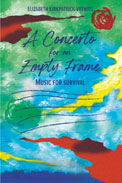
 |
when we stopped to swing around the light poles like children."
Divided into three movements to mimic an actual concerto, this book’s poems create a representation of the human emotional experience that makes its complexities accessible. Poems like “Early in Morning in Bethesda” examine a relationship’s tenderest moments. “Little Box” embraces an experimental form that is both peaceful and chaotic. “Grief at Full Moon” captures where loss compounds one’s interactions with not only the physical world but also the emotional one, and the memory of a loved one becomes a haunting force that controls one’s being. In other poems, the sanctity of nature becomes a healing, cleansing entity, while “the first grace of snow” offers a turning point in the speaker’s grief cycle. Fueling the musicality inherent in these poems are the experimental structures of lines and stanzas that form a concerto unlike any other.
Many of the poems in this collection challenge readers to push their emotional and psychological boundaries. Primarily, this occurs through the structural ranges and experimentations on which the author relies to ensnare numerous emotional ebbs and flows. Poems such as “New Marriage” appear in a standard, left-aligned form in which line enjambment facilitates the poem’s voice: “Standing in her kitchen, I escape / from the cream sauce and fish heads / of my Finnish past into the savory / bitterness of Greece.” However, as the collection progresses, readers not only embark on a structural, even linguistic, experience but also take a visual journey in poems like “The Rag Lady Casts a Spell (Cadenza).” This particular poem’s structure and visual effects allude to the Dadaists, whose bold font manipulations transformed poetry into something more than rhymes and left-aligned lines and stanzas. In this piece, readers journey through enlarged fonts and oddly angled text boxes filled with philosophical thoughts like “We bear it away some day, some day.” The placement of these boxes and lines creates a multilayered reading that allows for any number of interpretations.
Nonetheless, despite the experimental structures inherent in this collection, some of its best poems embrace a minimalist, Transcendentalist form and tone. One of the best examples of this aesthetic is “I moved out.” The poem itself is a call for self-preservation and self-discovery as the speaker moves to where they “will bloom / naming / what is impossible / to name.” Natural images like the dawn, the sunset, and shadows serve as metaphors for the transformations one undergoes during one’s life. It also reminds readers that they have the power to change their own lives and “name the sun / sunset / shadow” and that undergoing change is the only way one can grow. These poems encourage readers to take their darkest moments and convert them into moments of growth, change, and necessary transformation. Thus, these poems are poems for a dark world where hope seems far away because they indicate that, no matter what struggles one faces, one can find the strength to claim this world as one's own. Moreover, this collection reminds readers that poetry, too, is a powerful and necessary component in life and society, as are the experiences that make such poetry possible.
RECOMMENDED by the US Review